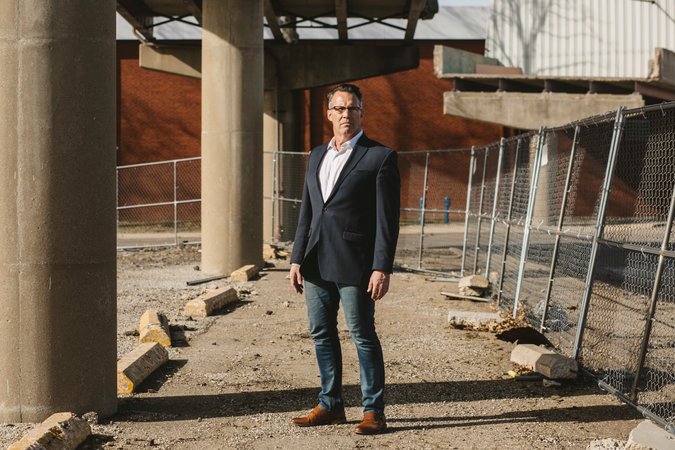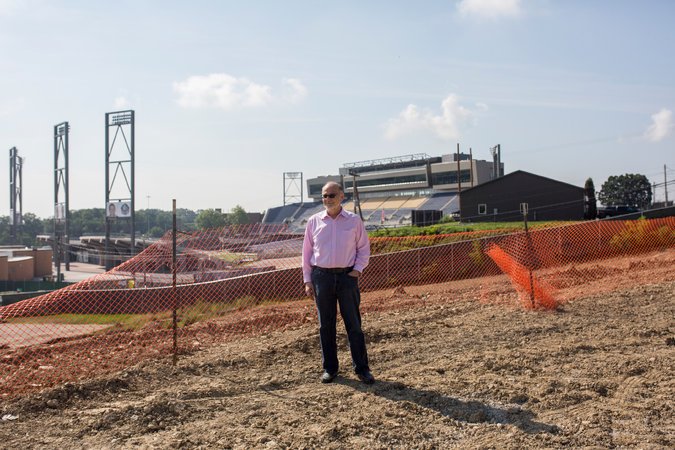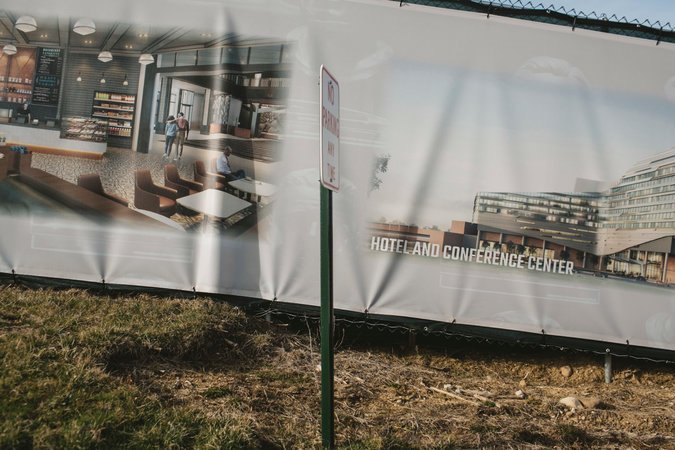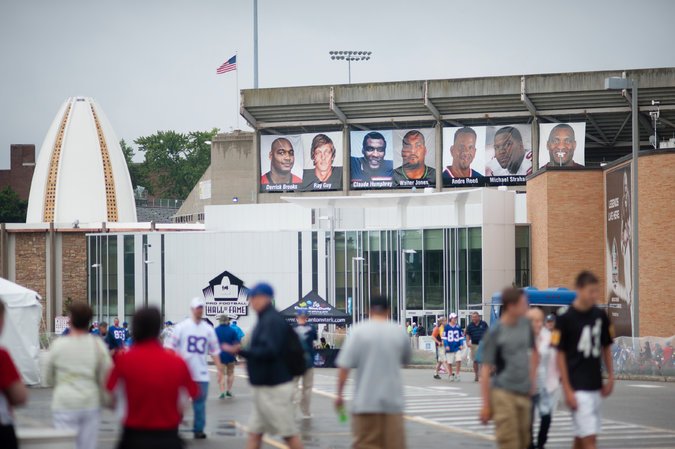Supported by
Sports
The Pro Football Hall of Fame Expansion Project Hits the Skids
The Pro Football Hall of Fame in Canton, Ohio, is supposed to become a Disney-esque, multiple-day destination with a four-star hotel, a state-of-the-art stadium, a water park, a youth sports complex, a retail promenade, a convention space, a 143-bed assisted living facility for retired Hall of Famers and a small hospital.
At the moment, however, it is a project with a skyrocketing budget, stalled progress, a developer with a checkered performance history in the region who has been accused of misusing $25 million in funds from a federal program, and contractors who recently went months without being paid. Financing problems have necessitated an emergency bank loan, and elected officials in Stark County have discussed a special ballot measure for a sales tax increase to subsidize the project known as Hall of Fame Village.
“You have to watch the warning signs when you are working with any developer,” said David Held, the mayor of North Canton, which has its own, ongoing fight with Industrial Realty Group, the developer of the Hall of Fame Village. “Sometimes the vision can be very big, but the planning and resources may not be in place like the local officials understood.”
Pete Fierle, a spokesman for the Pro Football Hall of Fame, which is not a part of the National Football League but has received millions of dollars in funding from the league, declined to discuss the development problems and the funding of the project. He did confirm contractors were recently paid.
Advertisement
Continue reading the main story
In a statement, a spokesman for the Hall of Fame Village claimed the project was moving forward.
“We’re making great progress on the project,” the statement said. “We have recently raised new financing for the project, and have satisfied outstanding obligations. We are adding new resources to the company and expect to raise additional capital to fully build out this exciting development.”
Continue reading the main story
The story of how something that began as a $25 million renovation of an old football stadium became an $1 billion, mixed-use mega-project is about two long-connected entities — local officials in Canton and Hall of Fame boosters — each hoping they could help solve each other’s problems.
Canton, an hour south of Cleveland in the heart of a region that has suffered hundreds of thousands of lost jobs in manufacturing during the past 50 years, needed something big to help boost the local economy. The Pro Football Hall of Fame needed local support to become something more than a museum near a declining stadium. The Hall attracts 225,000 visitors annually, but many of them come on a single weekend in early August.
No one will ever confuse Canton with Cooperstown, N.Y., home of the Baseball Hall of Fame, a picturesque town and well-known summer opera destination, with nearby ski areas and lakes that combine to make it a year-round destination for people who never set foot into the baseball museum. But if the Pro Football Hall of Fame can bring hundreds of millions of dollars in private investment to Canton, as well as millions of visitors, it could have a transformative effect on the city.
Bill Krueger, whose company performed an economic impact study about the project, told The Canton Repository in 2015 the development could be a “game changer” for not only “our local and regional economy, but all of Northeast Ohio.”
Dateline for an Origin Story
What would become the National Football League was founded in 1920, at a Canton car dealership. Jim Thorpe was elected its first president, and the Canton Bulldogs won two early championships. Financial troubles and the city’s small size caused the Bulldogs to fold in 1927, but Canton’s place at the heart of the game was secured in 1963, when the Pro Football Hall of Fame opened in town.
For the next 50 years, the Hall of Fame existed as a museum next to a small stadium — owned by the local school district — that attracted football enthusiasts and the N.F.L. once a year for its induction ceremony and preseason game. Then four years ago, the Hall of Fame announced a plan for a $25 million stadium upgrade, with the possibility of additional development.
In 2015, the Hall of Fame unveiled an expanded plan for what had become a $476 million Hall of Fame Village. An economic development report commissioned by the Hall projected a completion date of 2019, one million visitors by 2020 and three million by 2025.
Advertisement
Continue reading the main story
Months later, the complete rebuilding of Tom Benson Stadium began. The old Fawcett Stadium was renamed after the late owner of the New Orleans Saints when he donated $11 million toward construction. Much of that work was completed in time for an unveiling ceremony at the 2017 Hall of Fame game in August, though construction in one end of the stadium remains incomplete. The rebuild has cost at least $150 million so far.
Laborers worked double shifts and on weekends to get the stadium ready for the Hall of Fame game. Then, in September, contractors working on the stadium received only 60 percent of what they were owed, according to John Ross, a lawyer for four of the contractors. In January, the contractors filed liens against the project.

By early February, at least 18 mostly small and local contractors had filed over $8 million in liens. Not getting paid caused a “negative cascading effect on the finances” of the contractors he represents, Ross said.
I.R.G. finally paid the contractors last week. Ross said a number of them had gotten involved in the project because of its importance to Canton, but they will be hesitant to perform work on the Hall of Fame Village in the future without adequate assurances of sufficient funding.
The contractors were paid days after I.R.G. closed on an up-to-$100 million short-term loan for the project. The loan was provided by Great American Capital Partners, a Los Angeles-based finance company. Great American didn’t respond to messages requesting comment on the loan.
Financing documents filed with local authorities show about $35 million in funding for the stadium renovation is coming from various public sources. Another $13 million comes from donations made by Tom Benson and various foundations.
The project also no longer has a $476 million price tag. C. David Baker, the Hall president, has begun calling it a billion-dollar development, with most of the work yet to be completed. It isn’t clear if private funding can cover the costs, leading to discussions among local officials about potentially having to increase sales taxes to help fund the project. Such concerns dominated a recent meeting of local elected officials on economic development.
Richard Regula and Bill Smith, two of the three county commissioners who would have to approve a tax increase, said they are against it.
Advertisement
Continue reading the main story
“I know how the N.F.L. works,” Regula said, “and sometimes they rely on the local community to build them stadiums and things like that, and we simply can’t do that here in Stark County.”

Commissioner Janet Creighton could not be reached for comment.
N.F.L. Commissioner Roger Goodell and six N.F.L. owners are members of the Hall of Fame’s board of trustees. The N.F.L. did not respond to a request for comment.
A Lesson Nearby?
One of the biggest concerns about the project is that what is happening in nearby North Canton will happen to the Hall of Fame Village, too.
In 2007, the Hoover Company left North Canton for good, taking with them 2,400 jobs, contributing to a 25 percent loss of income tax revenue and leaving a 70-acre factory site empty. The next year Maple Street Investors — a partnership between Stuart Lichter, the president of I.R.G., and two local developers — bought the site of the former Hoover plant for $5 million.
By 2013 they had partially refurbished the site, retrofitting office and industrial space. About 1,100 people now work in the reimagined Hoover District. Much of that refurbishment was paid for by the public. Two grants from the state of Ohio accounted for about $5.8 million of the estimated $7 million of infrastructure work, Held, the North Canton mayor said. He considers this initial phase of construction a major success.
“We want them to succeed,” Held said. “When they succeed, it brings more jobs and revenue to the city.”
Developers were supposed to complete the second, much larger, phase of the project — which would include housing, restaurants and retail — by the end of 2015, but it is nowhere near done. Held said the developers conducted “a lot of promotion of the project, but they would start, and stop, and start, and stop.” He spent the end of 2017 imploring the developers to remove plywood from empty windows and put in glass, to make the site less of an eyesore, and to bring the buildings that had received work in compliance with building codes.
The $50 million second phase was supposed to be funded, at least in part, with $36 million from a federal program.

CMB Infrastructure Investment Group, which invested $36 million in the project, filed a lawsuit against Maple Street Investors and Lichter in 2016, claiming they violated federal rules governing the funding.
Advertisement
Continue reading the main story
According to the complaint, just two days after receiving the funds, Maple Street Investors “diverted at least $25,000,000 of the Loan proceeds.” CMB argued the $25 million went to intermediaries and was eventually lent to I.R.G., to complete the development of a former Goodyear campus in nearby Akron, Ohio.
In court documents, Lichter’s lawyers said $19.8 million of the money went to a company controlled solely by Lichter, and $16.2 million to a company controlled solely by Christopher Semarjian, one of his partners in the Hoover project. The lawyers could not provide a full accounting of the money because it was “commingled with unrelated funds,” but they said in court documents the two companies have continued to repay Maple Street Investors, which Lichter said CMB’s chief executive told him was allowed.
In early January, CMB and Maple Street Investors entered into a settlement agreement, and the lawsuit has been set aside for now. The agreement stipulated that Lichter and Maple Street Investors had 60 days to “pursue financing from a nonaffiliated commercial lender to pay a portion of the settlement amount” and 90 days to close the loan.
John Christie, a lawyer for CMB, declined to comment on the status of the case, or whether Maple Street Investors has obtained the money, though the 60 days have already passed.
Some local officials want to to know why the N.F.L. isn’t more involved in the process.
The Pro Football Hall of Fame is a nonprofit that is separate from the N.F.L. According to its most recent tax filing, in 2015 the organization had $29 million in revenue. About $9.5 million came from contributions; $5 million from government grants, and $4.5 million from unnamed contributors. According to The Canton Repository, the Hall of Fame has received “tens of millions” from the N.F.L. over the years.
The N.F.L. has also been an enthusiastic supporter of the Pro Football Hall of Fame Village. Goodell is good friends with Baker, who was formerly the commissioner of the Arena Football League, and has said he wants the league “to play a role in how this comes out.” The league will have office space in the completed village, and there is also a combined Cleveland/Canton bid to host the 2019 or 2020 N.F.L. draft. N.F.L. owners will choose the draft sites in May.
Held believes the N.F.L. should take more responsibility for the development, and ensure no more public money is spent on it.
“Before you put a shovel in the ground, it is just good business practice to make sure you have your short- and long-term financing in place,” he added. “Clearly, that was not done. It was either overbuilt, underfunded, or a combination of both.”
Email Kevin Draper at kevin.draper@nytimes.com or follow him on Twitter: @kevinmdraper.
Continue reading the main story Read the Original Article






























